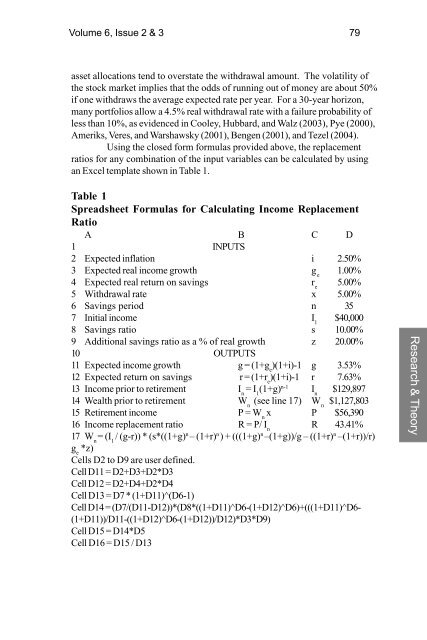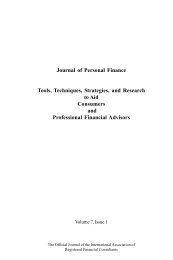3433-vol. 6 issue 2-3.pmd - iarfc
3433-vol. 6 issue 2-3.pmd - iarfc
3433-vol. 6 issue 2-3.pmd - iarfc
You also want an ePaper? Increase the reach of your titles
YUMPU automatically turns print PDFs into web optimized ePapers that Google loves.
Volume 6, Issue 2 & 3 79<br />
asset allocations tend to overstate the withdrawal amount. The <strong>vol</strong>atility of<br />
the stock market implies that the odds of running out of money are about 50%<br />
if one withdraws the average expected rate per year. For a 30-year horizon,<br />
many portfolios allow a 4.5% real withdrawal rate with a failure probability of<br />
less than 10%, as evidenced in Cooley, Hubbard, and Walz (2003), Pye (2000),<br />
Ameriks, Veres, and Warshawsky (2001), Bengen (2001), and Tezel (2004).<br />
Using the closed form formulas provided above, the replacement<br />
ratios for any combination of the input variables can be calculated by using<br />
an Excel template shown in Table 1.<br />
Table 1<br />
Spreadsheet Formulas for Calculating Income Replacement<br />
Ratio<br />
A B C D<br />
1 INPUTS<br />
2 Expected inflation i 2.50%<br />
3 Expected real income growth g e<br />
1.00%<br />
4 Expected real return on savings r e<br />
5.00%<br />
5 Withdrawal rate x 5.00%<br />
6 Savings period n 35<br />
7 Initial income I 1<br />
$40,000<br />
8 Savings ratio s 10.00%<br />
9 Additional savings ratio as a % of real growth z 20.00%<br />
10 OUTPUTS<br />
11 Expected income growth g = (1+g e<br />
)(1+i)-1 g 3.53%<br />
12 Expected return on savings r = (1+r e<br />
)(1+i)-1 r 7.63%<br />
13 Income prior to retirement I n<br />
= I 1<br />
(1+g) n-1 I n<br />
$129,897<br />
14 Wealth prior to retirement W n<br />
(see line 17) W n<br />
$1,127,803<br />
15 Retirement income P = W n<br />
x P $56,390<br />
16 Income replacement ratio R = P/ I n<br />
R 43.41%<br />
17 W n<br />
= (I 1<br />
/ (g-r)) * (s*((1+g) n – (1+r) n ) + (((1+g) n –(1+g))/g – ((1+r) n –(1+r))/r)<br />
g e<br />
*z)<br />
Cells D2 to D9 are user defined.<br />
Cell D11 = D2+D3+D2*D3<br />
Cell D12 = D2+D4+D2*D4<br />
Cell D13 = D7 * (1+D11)^(D6-1)<br />
Cell D14 = (D7/(D11-D12))*(D8*((1+D11)^D6-(1+D12)^D6)+(((1+D11)^D6-<br />
(1+D11))/D11-((1+D12)^D6-(1+D12))/D12)*D3*D9)<br />
Cell D15 = D14*D5<br />
Cell D16 = D15 / D13<br />
Research & Theory
















